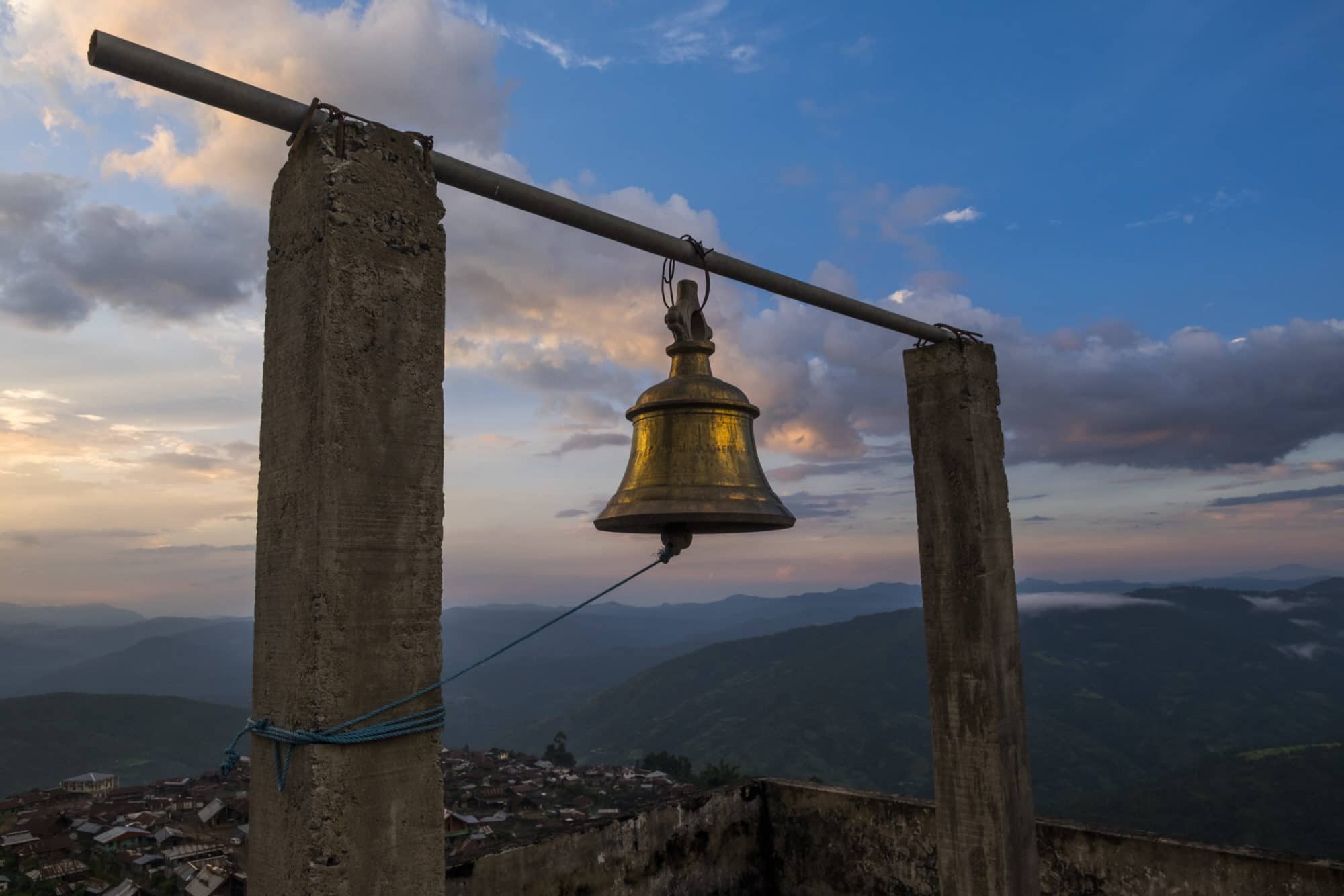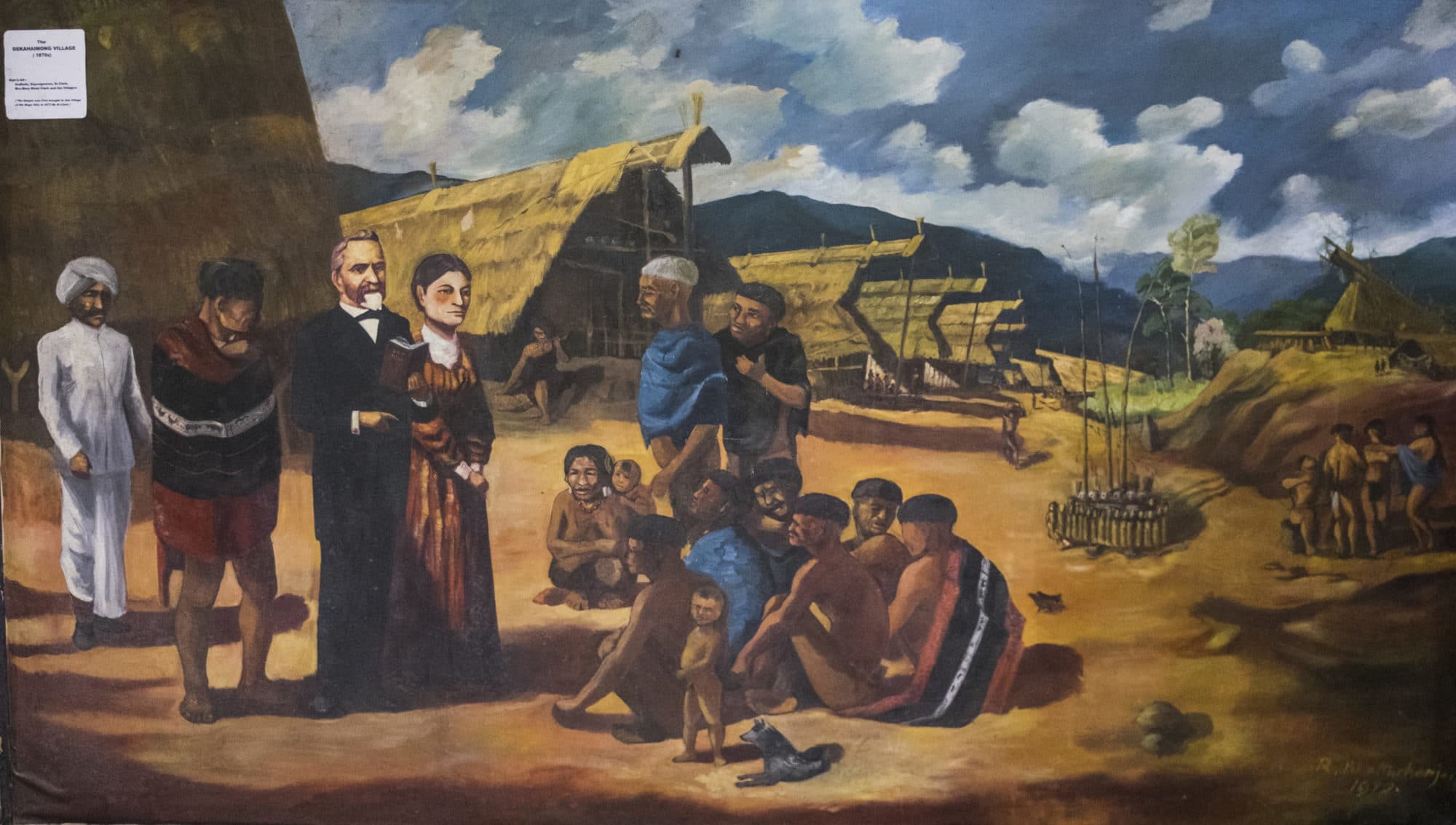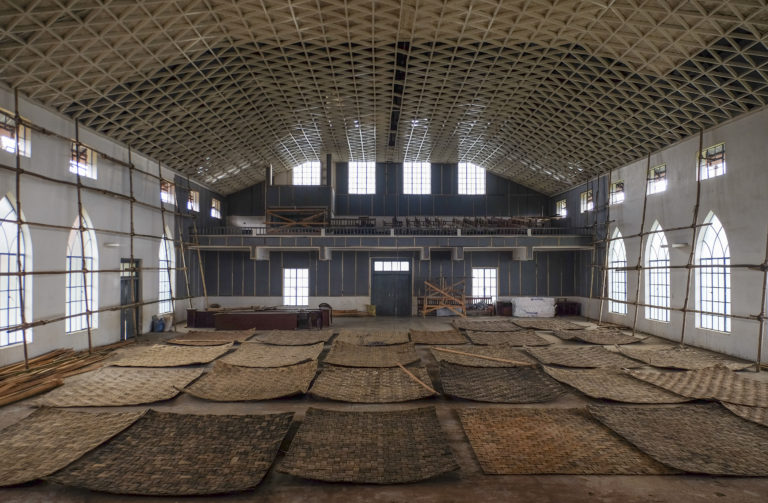We walked into the three storied church, one of the largest we had seen outside Kohima, and were struck by the simplicity of the house of worship. There was no ornate carvings or marble statues, just rows and rows of wooden pews, a podium in front with a mike and a section for the choir. We had heard women practicing their hymns in the evenings and one could imagine how beautiful it would sound in this large hall with high ceilings, wooden beams and nothing else. Outside the church, the sun was painting the sky a thousand shades of red, orange and yellow, creating one of the more stunning sunsets we had seen. Below we could see the entire village of Phusachodu, in central Nagaland, slowly growing darker as the sun disappeared below the horizon. The church was at the highest point in the village, as many were across the state, surveying the land around and keeping a watchful eye on its devotees.

Nagaland is said to be 99% Christian and the most Baptist state in the world. This was not rural Mississippi, but North Eastern India, bordering Myanmar on one side and Assam, Arunachal and Manipur on the other. Christianity came to Nagaland first through the missionaries or the white man as people term them, and then spread slowly through their followers, fellow Nagas, over a period of about a 100 years. Today it is not unusual to hear gospel music, as one might in parts of the deep south in the US, except here gospel is not only sung in English, but in Nagamese or the local tribal language. In a land that still eats almost everything that moves (or so the joke goes), drinks home brewed rice beer and practices polygamy in parts, Christianity has a very loose and unusual relationship with a people that were once fiercely tribal and probably enjoyed a lot more social freedoms than they do today. Unlike Kerala, where religion and tradition seem to have struck some sort of balance, here the battle between a people that are new converts and their age old customs still wage under the surface.

Travelling across the state we found several expressions of the religion, some more obvious than others. Some villages, in the Mokukchung region for example, home to the Ao tribe, where Christianity first started, is more deeply religious than most of the other regions. Here, and in certain other regions, we found people content and proud of their new faith, one that gave them purpose and an anchor. They believe that the religion has given them a sense of belonging. Impur, in Mokokchung region, is home to the largest Mission Compound, and also a small museum dedicated to Dr. Edwin Clark. The museum, if one can call it that, is a small room with an enormous bust of Dr Clark and his wife, and is also chock a block full of their personal effects, and stuff from their home that is still intact. Small as it might be, the museum is an interesting find and if you find yourself in the area, we suggest a drop in. The duplication machine and book binding machine used by Dr Clarke from the 1870s, the blacksmith bellow from the early 1930s and other similar artefacts alone warrant a visit if that sort of thing interests you.

Born in 1830 Boston, Dr E Clarke and his wife, of the Baptist faith, reached Sibsagar (now Sivasagar) in eastern Assam in 1860. It is said that he met some Nagas in the region who had come down to the plains in search of food and realized his true calling was to bring christian teachings to people who had no knowledge of Christ. With the help of his first Naga convert, he soon began spreading his message to the tribals of the Naga Hills. One must admire his faith and dedication, for he not only learnt the language of the tribe, but also took time to understand their way of life and customs, thus gaining the trust of the people. He faced a lot of resistance since the only experience the tribals had to the white man were the British, whom they disliked. The Ao people, the tribal group closest to Assam geographically, were the first converts, with the little village of Molung becoming the first Baptist Christian community in the Naga Hills. By 1894 Molung became the center of the Baptist Church, which later moved to Impur. Dr Clark left the Naga Hills for the last time in 1911 and left in his stead other missionaries and American families to continue his work. By the 1950s, almost all of Nagaland had converted to Christianity, a majority of whom are Baptist, with a smaller minority of Catholics, Pentecostals, Revivalists and other denominations.

Interestingly, villages in other parts of the state, where Christianity came later, are different in several ways. Mon region for example, home to the Konyak tribe, all the way up in the north and east of the state, bordering Myanmar and Arunachal, is still clinging to its tribal roots and old customs. Here, many are Christian only in name, literally that is, and aren’t very good practicing Christians as they tell you themselves. They still practice traditional ways of life, church is meant for Sundays, if that, and perhaps the occasional wedding. Life here in many villages is not very different from what it probably was 50 years ago, with the one exception that headhunting and the display of skulls won in battle is no longer practiced. Some of the elders also admit that the new religion has brought peace and a freedom of movement that they enjoy. The people in outlying villages of Mon still hunt, many partake in opium and celebrate traditional festivals and feasts, and the idea of being a Christian is just that, an idea.

Christianity, a friend here told us, for many was a means to education. Something we had learnt from several other host families in villages across the state. Schools were opened either by missionaries or by new converts, and parents would often times convert so they could send their children to the schools for a good education. In a state that has been grappling with socio-political problems for over 50 years with Delhi, the Christian missions and coverts have often done a faster and better job of bringing education to the deeper reaches of the Naga Hills than the government. Education is further a means of development and a link to the outside world of modernity, jobs and new forms of livelihood. The land is not enough, and similar to other parts of the world, the young are setting out to seek other pastures. Many, like in the village of Phusachodu, of the Chakesang tribe, believe that they are more backward than their Ao or Angami brothers, because Christianity and thus education came to their district much later than other regions. There might be some truth in this, for the village which falls in Phek district, fairs lower in certain socio-economic indicators. Here the younger generation all to go to school: every morning at 7.30am, while sipping our tea, we could see scores of kids, of all ages, rushing to reach school in time. Most of the schools are run by the church, though many of the larger villages also have government schools. The older daughter of our homestay family, a school teacher, spoke fluent English, but many in her generation (people in their mid 30’s) in the village do not, she said.
The dream that Dr Clark once had has most certainly come true, though perhaps not quite in the way he envisaged. Christianity might have ended the practice of headhunting, put clothes on an entire population, changed their eating and other habits, and brought them education, but (thankfully) it has not wiped out all their animistic traditions and customs, proud way of life and their fierce relationship to nature; at least not for another couple of generations.

Very nicely written! I remember researching about the evangelist Clark and thinking exactly the same as you did– he must’ve had some guts and determination to undertake such a mammoth task of entering Naga Hills where even the British feared to enter with all their means. I only visited Longwa in Nagaland and remember asking my host about her belief in Christianity and she was absolutely nonchalant about it. It makes sense now after reading your post that many might have converted only to access education and other opportunities.
Great article, looking forward to reading more of your updates.
Thanks Neelima. It was quite an interesting revelation to understand their relationship with the religion. We found a few extremes amongst people in different regions. It’s a fascinating place, putting some new stuff soon! 🙂
Very educational and a wonderful read. I learnt so much about a state I knew nothing of and to think it is part of the diversity that makes us Indian!
Am proud to know you both and your love for adventure and sharing these experiences on your travels.
I wish I could send this to all those millions who paint our countrymen with one monotone!
Warm Regards, Harshal
Thanks Harshal, Nagaland has been incredible and we have many more stories to share. India is a technicolour feast and those who paint her in a monotone suffer from acute tunnel vision!